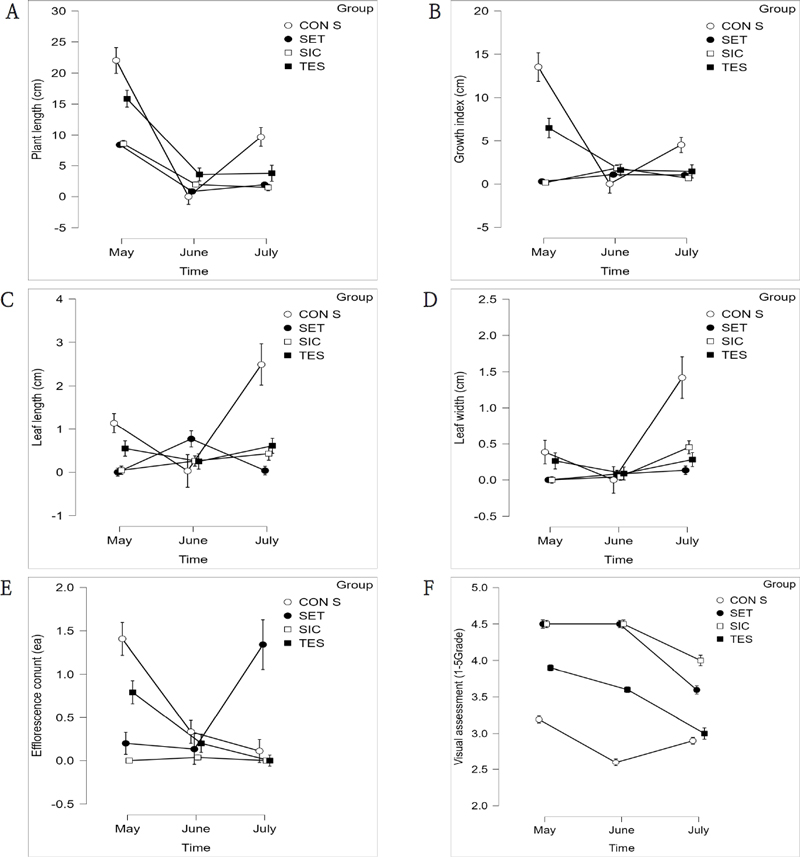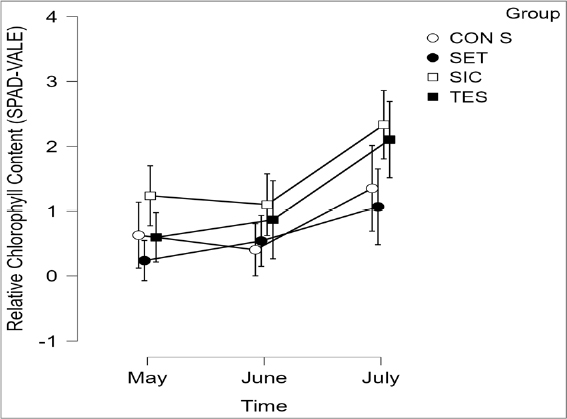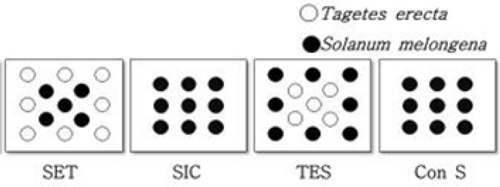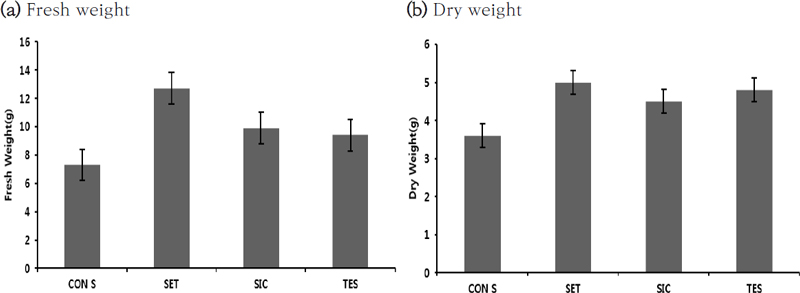
친환경 옥상 도시농업 활성화를 위한 배식모형에 따른 가지(Solanum melongena)와 메리골드(Tagetes erecta) 식재효과
ⒸThe Korean Environmental Sciences Society. All rights reserved.
This is an Open-Access article distributed under the terms of the Creative Commons Attribution Non-Commercial License (http://creativecommons.org/licenses/by-nc/3.0) which permits unrestricted non-commercial use, distribution, and reproduction in any medium, provided the original work is properly cited.
Abstract
This study investigated the effects of various planting models on the joint cultivation of eggplant (Solanum melongena) and marigold (Tagetes erecta)to enhance sustainable rooftop urban farming. Rooftop agriculture is increasingly valued to boost the food supply and benefit the environment. Integrating such practices into urban planning is viewed as a way to sustainably manage resources and improve the food-energy-water cycle in cities. The experiment was conducted on a rooftop in Chungju, South Korea from May to August. Four different planting setups were used: central eggplant with peripheral marigold (SET), eggplant with a protective net (SIC), central marigold with peripheral eggplant (TES), and control with only eggplant (CON S). These models tested the effects of companion planting versus monoculture using a lightweight soil mix ideal for rooftops made from cocopeat and perlite and enriched with organic fertilizer. Measurements focused on soil conditions and plant health and assessed soil temperature, moisture, conductivity, plant height, width, and leaf size. The results indicated that the SET modelyielded the best growth. This setup benefited from marigold pest control properties and its ability to improve soil conditions by enhancing moisture and nutrient levels and aiding eggplant growth. These findings underscore the potential of mixed planting on rooftops and suggest that such approaches can be effectively incorporated into urban agriculture to boost yield and environmental sustainability. This study supports the idea that diverse planting methods can significantly affect plant growth and promote urban greening and food security.
Keywords:
Companion plant, Agriculture environm, Ecological benefits, Aromatic plants, Pest control1. 서 론
도시농업에서 옥상농업의 중요성은 식량 공급 증진과 환경에 미치는 긍정적인 영향으로 인해 점점 더 인식되고 있다. 최근 연구에서는 옥상농업을 도시농업 확장의 실질적인 방안으로 보고 있으며, 이를 도시 계획에 통합할 필요성을 강조하였다(Harada and Whitlow, 2020). 또한, Huang and Chang(2021)은 옥상농업이 물과 에너지의 지속 가능한 관리를 통해 도시 내 물-에너지-식량 순환을 촉진할 수 있다고 밝혔다. Appolloni et al.(2021)과 Choudhary and Rawat(2021)을 포함한 연구들은 옥상농업이 도시 환경과 사회에 제공할 수 있는 다양한 이점들을 조명하며, 그 실행 가능성과 긍정적인 영향을 강조하고 있다.
옥상농업 공간의 재배 환경을 개선하기 위한 다양한 방법 중에서 공영식재를 활용한 방법이 제안되고 있다 (Thapa et al., 2021). 이는 친환경적 해충 관리 방법으로서 작물의 수확량을 증진시킨다(Wan et al., 2018). 또한, 다양한 작물 간의 상호작용은 영양분 흡수와 작물 품질 향상 등을 통해 환경 개선에 기여하는 역할을 한다(Iqbal et al., 2018; Xia et al., 2019; Gajbe, 2020).
옥상농업 식물로써 가지(Solanum melongena)는 다양한 환경에 적응하고 높은 온도 및 수분 조건에 내성이 있어, 옥상농업에 적합한 과채류이다(Sanyè-Mengual et al., 2015). 하지만 가지는 병해충에 취약하여 수확량과 품질에 영향을 미칠 수 있으므로, 병해충 관리가 중요하다(Kashyap et al., 2003). 공영식물로써 메리골드(Tagetes erecta)는 다양한 색상과 특성으로 관상용, 식품, 화장품, 향수 등의 제조에도 활용되며(Ravi et al., 2017; Tamut et al., 2019), α-terthienyl과 같은 화합물을 생성하여 작물 보호 역할을 한다(Hooks et al., 2010). 선행 연구에 따르면, 메리골드를 토마토와 같은 과채류에서 공영식물로 사용할 때 해충 손상과 유충 밀도가 감소함으로써 효과적인 해충 관리가 가능하다는 것을 보여준다(Srinivasan, Moorthy, & Raviprasad, 1994; Kumar V, Prakash, & Mishra, 2023; Pathan et al., 2023).
따라서, 본 연구는 메리골드를 이용한 공영식재 방식과 배식 모형이 가지와 같은 병해충에 취약한 작물의 보호에 어떻게 기여하며, 공영식물로서의 상호작용 효과를 나타내는지를 연구하고자 한다.
2. 재료 및 방법
2.1. 실험구
본 실험구는 다양한 배식 모형을 통해 공영식물(초화류-과채류)의 식재 효과를 검증하고, 식재종 간 상호 영향력이 시간 경과와 함께 식재 비율 및 형태에 따라 어떻게 변화하는지 조사하기 위해 설치하였다. 이 연구는 5월부터 8월까지 충청북도 충주시에 위치한 복합실습동 옥상(36°58' 14.2" N, 127°55' 57.6" E)에서 수행되었다. 실험구는 가로 1 m, 세로 1 m, 높이 0.25 m 크기로 조성되었으며, 배수관 설치 후 토양 유실 방지를 위해 여과층 부직포를 깔고 인공배합토와 유기질 비료를 혼합하여 토심 약 20 cm 높이로 15개 실험구에 포설하였다. 유형별로 4가지 배식 모형을 3반복 처리하여 조성한 실험구는 중앙에 가지 공영식재와 가장자리에 메리골드 공영식재(SET), 가지 단일식재 후 물리적 방제를 위한 방충망 설치(SIC), 중앙에 메리골드 공영식재와 가장자리에 가지 공영식재(TES), 그리고 가지만 단일식재한 대조구(CON S) 등으로 구성되었다(Fig. 1).
2.2. 실험재료
토양재료는 옥상녹화에 적합한 경량형 인공토양인 코코피트(Fourseason, Samhwa-greentech, Korea)와 펄라이트(Perlite, Homan Industry, Korea) 혼합물을 사용하였다. 코코피트와 펄라이트 혼합물은 옥상의 하중 문제를 고려하였다. 특히, 높은 수분 보유 능력과 낮은 포화 수리전도도를 특징으로 하여, 옥상녹화의 토양 재료로써 이상적이다(Ilahi & Ahmad, 2017). 가지의 적정 시비량을 고려하여, 이 혼합물에 유기질 비료 10%를 추가함으로써 영양분 부족 문제를 해결하였다. 식물재료는 과채류의 가지(Solanum melongena)와 초화류의 메리골드(Tagetes erecta)를 선정하였다. 따라서, 코코피트와 펄라이트 기반의 경량형 인공토양을 기반으로 공영식물로 메리골드를 이용한 해충 관리가 가지와 같은 취약한 작물의 보호에 기여하는지 알아보고자 하였다.
2.3. 자료수집
배식 모형에 따른 공영식물 식재 효과를 검증하기 위해 토양 환경과 식물 생육 및 생리 상태를 포괄적으로 측정하였다. 토양 측정은 토양 온도, 토양 수분, 토양 전기 전도도를 포함하며, 토양 측정기(WT-1000, RFSENSOR, Korea)를 사용하여 연구 기간 동안 1개월 간격으로 측정하였다. 식물 측정은 식물의 생육을 초장(H), 초폭(W1, W2), 엽장, 엽폭으로 측정하고, 줄자와 30 cm 자를 활용하여 측정하였다. 생장지수(GI; Growth Index)는 ([(초폭1)+(초폭2)]/2+초장)/2의 산정식으로 계산하였다(Hammond et al., 2007). 시각적 평가는 5점으로 나눠서 5점 ‘거의 없음(0~10%)’, 4점 ‘경미함(10~30%)’, 3점 ‘보통(30~50%)’, 2점 ‘심함(50~70%)’, 1점 ‘매우 심함(70% 이상)’으로 병충해를 육안 확인하였다. 식물의 생리 측정 항목으로는 상대 엽록소 함량, 생체 무게, 건조 무게를 조사하였다. 월 1회 생육 결과를 측정하였다.
엽록소 측정기(SPAD-502, MINOLTA, Japan)를 이용해 식물의 상대 엽록소 함량을 측정하고, 한 실험구당 식물의 잎을 3반복 측정하여 평균값을 도출하였다. 실험 종료 후, 식물을 채취하고 뿌리의 흙을 제거한 뒤 지상부와 지하부를 구분하여 미세 전자 저울(MS300HS, MISUNG, Korea)로 생체 무게를 측정하였다. 식물의 건조 무게는 가지와 메리골드를 지상부와 지하부로 나눈 후, 60~70℃에서 48시간 동안 식물 건조기에서 건조 시킨 후 미세 전자 저울로 측정하였다.
2.4. 자료분석
배식모형에 따른 공영식물 식재효과를 검증하기 위하여 실험구별 생육상태의 평균간 비교를 실시하였으며, 통계분석은 SPSS Ver. 18.0(SPSS Inc., USA)를 이용하여 반복측정 분산분석을 실시하였으며, 시간변화에 따른 생육차이가 처리구 유형별로 통계적인 차이가 있는 것으로 분석된 항목에 한하여 Duncan의 다중범위검정(Multiple rage test)을 사후검정으로 적용하였다 (p < 0.05).
3. 결과 및 고찰
3.1. 토양환경
배식모형에 따른 토양의 특성을 분석하였다(Table 1). 실험구별 토양 온도, 토양 수분, 토양 전기 전도도는 각각 다른 경향을 보였다. 토양 온도의 경우, SIC 실험구가 5월 22.2℃, 6월 27.9℃, 7월 37.9℃로 평균 29.3℃를 기록하며 가장 높았고, SET 실험구는 5월 21.5℃, 6월 29.2℃, 7월 32.5℃로 평균 27.7℃로 가장 낮은 평균값을 나타냈다. 토양 수분은 SET 실험구에서 5월 27.8%, 6월 31.8%, 7월 33.9%로 평균 31.0%를 기록하여 가장 높은 수치를 보였으며, 반면 CONS 실험구는 5월 22.5%, 6월 35.1%, 7월 24.2%로 평균 24.0%로 가장 낮았다. 토양 전기 전도도는 SET 실험구가 5월 0.10 ds/m, 6월 0.07 ds/m, 7월 0.41 ds/m로 평균 0.19 ds/m을 기록하며 가장 높은 전기 전도도를 보인 반면, SIC 실험구는 5월 0.03 ds/m, 6월 0.01 ds/m, 7월 0.21 ds/m로 평균 0.08 ds/m으로 가장 낮은 값을 보였다. 메리골드를 공영식재할 경우, 토양 온도가 낮아지고 토양 수분 및 전기 전도도가 증가하는 경향이 관찰된다. 반면, 방충망 사용은 토양 온도를 높이고, 수분 및 전기 전도도를 감소시키는 효과가 있다. Li et al.(2020)의 연구에 따르면 메리골드를 공영식재함으로써 토양의 물리화학성이 개선된다고 하며, 이는 배식 모형에 따라 토양 조건이 달라질 수 있음을 보여준다.
3.2. 가지 생육 특성
배치 모형에 따른 가지 생육 항목별 3개월간 월 성장률 분석하였으며(Fig. 2), 통계적 비교 분석하였다(Table 2). 초장은 CON S(-12.34 cm) > TES (-12.09 cm) > SIC(-7.08 cm) = SET(-6.44 cm) 순으로 감소하였다(p < 0.05). 생장지수는 SIC(+0.75 cm) = SET(+0.51 cm) > TES(-5.05 cm) > CON S(-9.01 cm) 순으로 증감하였다(p < 0.05). 엽장은 CON S (+1.36 cm) > SIC(+0.39 cm) = TES(+0.06 cm) = SET(+0.04 cm) 순으로 증가하였다(p < 0.05). 엽폭은 CON S(+1.03 cm) > SIC(+0.45 cm) = SET(+0.13 cm) = TES(+0.02 cm) 순으로 증가하였다(p < 0.05). 결실수는 SET(+1.14 ea) > SIC(+0.01 ea) > TES (-0.79 ea) > CON S(-1.31 ea) 순으로 증감하였다(p < 0.05). 또한, 시각적 평가 점수는 SIC(4.0) > SET(3.6) > TES(3.0) = CONS(2.9) 순으로 높았다(p < 0.05). 결과적으로 메리골드를 외곽에 배치하고 가지를 보호함으로써 초장 및 생장지수가 향상되었으며, 병충해 방지 효과와 결실량도 증가하였다. 메리골드는 병충해 발생을 감소시키고 수확량을 높이는 공영식물로서의 역할을 수행한다(Ploeg 2002, Gomez-Rodriguez et al., 2003, Tibugari et al., 2012). 또한, 식물의 낮은 높이가 광환경을 개선하여 작물 생장을 촉진한다는 선행 연구(Kim et al., 2008; Hong et al., 2022)와 일치하며, 메리골드의 외곽 배치가 해충 피해 감소와 수확량 증가에 효과적임을 보여준다(Xie et al., 2016). 하지만 엽장 및 엽폭의 생장은 가지를 단일 식재한 대조구 비하여 낮은 성장을 나타냈다.

Solanum melongena growth characteristics and variation by planting model; Plant length (A), Growth index (B), Leaf length (C), Leaf width (D), Fruiting tree (E) Visual assessment (F); Con S: Single Solanum melongena, SET: Square Tagetes erecta + Clustered Solanum melongena, SIC: Single Solanum melongena + Insect-proof net, TES: Square Solanum melongena + Clustered Tagetes erecta; The analysis indicated that all measured variables showed significant changes over time (p < 0.05) and significant interactions between time and treatment groups (p < 0.05), with corrections for sphericity violations applied as necessary, ensuring the findings' statistical significance.
3.3. 가지 생리 특성
배치 모형에 따른 가지의 상대엽록소 함량을 3개월간 월 변화율을 분석하였으며(Fig. 3), 통계적 비교 분석하였다(Table 3). 변화값은 TES(+1.49 SPAD-VALE) = SIC(+1.01 SPAD-VALE) = SET(+0.83 SPAD-VALE) = CON S(+0.72 SPAD-VALE) 순으로 증가하였다(p > 0.05). 이 연구 결과는 공영식재 및 배치 모형에도 불구하고 가지의 상대엽록소 함량에 유의미한 차이가 없음을 보여준다. 이는 특정 배치나 식재 방식이 가지의 광합성 능력에 미치는 영향이 제한적일 수 있음을 시사한다(Aminifard et al., 2010; Pan et al., 2020).

Relative Chlorophyll Content of Solanum melongena by Planting Model; Con S: Single Solanum melongena, SET: Square Tagetes erecta + Clustered Solanum melongena, SIC: Single Solanum melongena + Insect-proof net, TES: Square Solanum melongena + Clustered Tagetes erecta; The analysis indicated that all measured variables showed significant changes over time (p < 0.05) and significant interactions between time and treatment groups (p < 0.05), with corrections for sphericity violations applied as necessary, ensuring the findings' statistical significance.
가지의 생체중과 건조중 측정 결과는 가지의 식재 위치가 생육에 미치는 영향을 분명히 보여준다(Fig. 4). 생체중 측정에서는 중앙부에 심은 SET 실험구의 가지가 12.7 g으로 가장 높은 값을 나타내었으며, 이는 가지가 메리골드와 함께 중앙부에 식재될 때 가장 우수한 생육을 보임을 의미한다. SIC 실험구의 가지 생체중은 9.9 g으로 두 번째로 높았고, TES 실험구는 9.4 g으로 그 다음이었다. 단일로 식재된 CON S 실험구에서의 가지 생체중은 7.3 g으로 가장 낮았다. 건조중 측정에서도 유사한 경향이 관찰되어, SET 실험구가 5 g으로 가장 높은 무게를 기록했으며, 이어서 TES가 4.8 g, SIC가 4.5 g, CON S가 3.6 g 순이었다. 선행 연구에서는 여름철 고온의 토양 온도(Rylski et al., 1976) 및 수분 결핍(Wakchaure et al., 2020)이 가지의 생육과 품질을 저하시킨다고 하였다. 이에 대한 앞선 토양 환경 분석에서는 메리골드가 토양 온도 저감과 수분 함량 증가에 영향을 미친다고 하였으며, 이는 배치 모형에 따라 달라질 수 있다고 하였다. 이러한 결과가 가지의 생육에 영향을 미친 것으로 사료된다.
4. 결 론
본 연구에서는 친환경 옥상 도시농업 활성화를 위한 다양한 배식모형에 따른 가지와 메리골드의 공영식재 효과를 분석하였다. 실험 결과는 배식 모형이 가지의 생육 및 생리 특성에 유의미한 영향을 미치며, 특히 메리골드와 함께 중앙에 식재된 SET 실험구에서 가장 우수한 생육 결과를 나타냈다. 이는 메리골드가 해충 방지 및 토양 온도와 수분 함량 조절에 긍정적인 역할을 함으로써, 가지의 생육 조건을 효과적으로 개선하는 것으로 나타났다. 또한, 실험을 통해 메리골드가 토양의 물리화학적 조건을 개선하며, 이는 가지의 생육에 유리한 환경을 제공하는 것으로 확인되었다. 메리골드의 공영식재는 토양 온도를 낮추고, 수분함량 및 전기 전도도를 증가시키는 등의 효과가 있어, 병해충 관리뿐만 아니라 토양 환경 개선에도 중요한 역할을 한다는 점을 확인하였다. 이러한 결과는 옥상농업의 다양한 식물 간 공영식재의 활용 가능성을 시사한다. 특히, 도시 옥상과 같이 제한된 공간에서의 농업 활동에 있어서 공영식물을 활용한 친환경 재배 방법이 농작물의 생육뿐만 아니라 환경적 지속 가능성에 기여할 수 있다. 본 연구는 옥상 도시농업의 가능성을 확장하며, 친환경 도시 농업을 촉진하는 데 중요한 기초 자료를 제공할 것이다. 더 나아가, 향후 연구에서는 다양한 종류의 공영식물과 그 배식모형에 따른 심층적인 분석이 이루어져야 할 필요가 있다.
REFERENCES
- Aminifard, M., Aroiee, H., Fatemi, H., Ameri, A., 2010, Performance of eggplant (Solanum melongena L.) and sweet pepper (Capsicum annuum L.) in intercropping system under different rates of nitrogen, Hort. Environ. Biotechnol., 51, 367-372.
-
Appolloni, E., Orsini, F., Specht, K., Thomaier, S., Sanye, Mengual, E., Pennisi, G., Gianquinto, G., 2021, The global rise of urban rooftop agriculture: A Review of worldwide cases, J. Clean. Prod., 296, 126556.
[https://doi.org/10.1016/j.jclepro.2021.126556]

-
Choudhary, M., Rawat, A., 2021, Rooftop gardening a modern approach of production in urban areas: A Review, Bhartiya Krishi Anusandhan Patrika, 36, 212-214.
[https://doi.org/10.18805/BKAP337]

-
Gajbe, P., 2020, Urban rooftop farming model for sustainable vegetable production and environmental well-being, Agric. Sci. Digest, 41, 211-214.
[https://doi.org/10.18805/ag.D-5215]

-
Gomez-Rodriguez, O., Zavaleta-Mejia, E., Gonzalez-Hernandez, V., Livera-Munoz, M., Cardenas-Soriano, E., 2003, Allelopathy and microclimatic modification of intercropping with marigold on tomato early blight disease development, Field Crop Res., 83, 27-34.
[https://doi.org/10.1016/S0378-4290(03)00053-4]

-
Hammond, H. E., Norcini, J. G., Wilson, S. B., Schoellhorn, R. K., Miller, D. L., 2007, Growth, flowering, and survival of firewheel (Gaillardia pulchella foug.) based on seed source and growing location, Native Plants J., 8, 25-39.
[https://doi.org/10.2979/NPJ.2007.8.1.25]

-
Harada, Y., Whitlow, T., 2020, Urban rooftop agriculture: Challenges to science and practice, Front. Sustain. Food Syst., 4, 76.
[https://doi.org/10.3389/fsufs.2020.00076]

-
Hong, I., Yun, H., Jung, Y., Lee, S., Lee, S., 2022, Selection of companion plants for pest control of cruciferous crops, J. People Plants Environ., 25, 337-348.
[https://doi.org/10.11628/ksppe.2022.25.4.337]

-
Hooks, C., Wang, K., Ploeg, A., Mcsorley, R., 2010, Using marigold (Tagetes spp.) as a cover crop to protect crops from plant-parasitic nematodes, Appl. Soil Ecol., 46, 307-320.
[https://doi.org/10.1016/j.apsoil.2010.09.005]

-
Huang, A., Chang, F., 2021, Prospects for rooftop farming system dynamics: An Action to stimulate water-energy-food nexus synergies toward green cities of tomorrow, Sustainability, 13, 9042.
[https://doi.org/10.3390/su13169042]

-
Ilahi, W., Ahmad, D., 2017, A Study on the physical and hydraulic characteristics of cocopeat perlite mixture as a growing media in containerized plant production, Sains Malays., 46, 975-980.
[https://doi.org/10.17576/jsm-2017-4606-17]

-
Iqbal, N., Hussain, S., Ahmed, Z., Yang, F., Wang, X., Liu, W., Liu, J., 2018, Comparative analysis of maize-soybean strip intercropping systems: A Review, Plant Prod. Sci., 22, 131-142.
[https://doi.org/10.1080/1343943X.2018.1541137]

-
Kashyap, V., Kumar, S., Collonnier, C., Fusari, F., Haicour, R., Rotino, G., Sihachakr, D., Rajam, M., 2003, Biotechnology of eggplant, Sci. Hort., 97, 1-25.
[https://doi.org/10.1016/S0304-4238(02)00140-1]

- Kim, K. D., Ahn, J. H., Lee, J. T., Hong, S. C., Hwang, S. W., Kim, C. G., 2008, Evaluation of companion crop for conservation of soil in highland cultivation of Chinese cabbage, J. Bio-Environ. Control., 17, 1-8.
-
Kumar, V. A., Prakash, S., Mishra, M., 2023, Marigold as a trap crop for the management of tomato fruit borer, helicoverpa armigera in Taral region of Uttar pradesh, The Scientific Temper, 3, 65-68.
[https://doi.org/10.58414/SCIENTIFICTEMPER.2012.03.1.12]

-
Li, Y., Feng, J., Zheng, L., Huang, J., Yang, Y., Li, X., 2020, Intercropping with marigold promotes soil health and microbial structure to assist in mitigating tobacco bacterial wilt, J. Plant Pathol., 1-12.
[https://doi.org/10.1007/s42161-020-00490-w]

-
Pan, S., Lu, R., Li, H., Lin, L., Li, L., Xiang, J., Chen, L., Tang, Y., 2020, Mutual intercropping affects selenium uptake of eggplant seedlings, Int. J. Environ. Anal. Chem., 101, 2866 - 2875.
[https://doi.org/10.1080/03067319.2020.1711900]

-
Pathan, S. N., Solangi, A. W., Marri, J. M., Lanjar, A. G., Bukero, A., 2023, Eco-friendly approaches against chili thrips scirtothrips dorsalis hood (Thysanoptera: Thripidae), Plant Prot., 7, 545-553.
[https://doi.org/10.33804/pp.007.03.4905]

-
Ploeg, A. T., 2002, Effects of selected marigold varieties on root-knot nematodes and tomato and melon yields, Plant Dis., 86, 505-508.
[https://doi.org/10.1094/PDIS.2002.86.5.505]

-
Ravi, C., Naik, B., Chaithra, G., Harish, S., 2017, Nutrient status of soil and plant and total diomass as influenced by liquid formulations of EM consortia with graded levels of NPK in marigold (Tagetes erecta L.) cv. double orange, Int. J. Curr. Microbiol. Appl. Sci., 6, 1456-1463.
[https://doi.org/10.20546/ijcmas.2017.611.174]

-
Rylski, I., Nothmann, J., Spiegelman, M., 1976, Effects of soil temperature on the development of young eggplants (Solanum Melongena), Exp. Agric., 12, 273-277.
[https://doi.org/10.1017/S0014479700100547]

-
Sanye-Mengual, E., Orsini, F., Oliver-Sola, J., Rieradevall, J., Montero, J., Gianquinto, G., 2015, Techniques and crops for efficient rooftop gardens in Bologna, Italy, Agron. Sustain. Dev., 35, 1477-1488.
[https://doi.org/10.1007/s13593-015-0331-0]

-
Srinivasan, K., Moorthy, P., Raviprasad, T., 1994, African marigold as a trap crop for the management of the fruit borer Helicoverpa armigera on tomato, Int. J. Pest Manag., 40, 56-63.
[https://doi.org/10.1080/09670879409371854]

-
Tamut, O., Singh, K., Panwar, S., 2019, Variations in quantitative and aualitative composition of essential oils from leaves and flowers of french marigold (Tagetes patula), Int. J. Curr. Microbiol. Appl. Sci., 6.
[https://doi.org/10.20546/ijcmas.2019.807.124]

-
Thapa, S., Nainabasti, A., Bharati, S., 2021, Assessment of the linkage of urban green roofs, nutritional supply, and diversity status in Nepal, Cogent Food Agric., 7, 1911908.
[https://doi.org/10.1080/23311932.2021.1911908]

- Tibugari, H., Mombeshora, D., Mandumbu, R., Karavina, C., Parwada, C., 2012, A Comparison of the effectiveness of the aqueous extracts of garlic, castor beans and marigold in the biocontrol of root-knot nematode in tomato, J. Agr. Tech., 8, 479-492.
-
Wakchaure, G., Minhas, P., Meena, K., Kumar, S., Rane, J., 2020, Effect of plant growth regulators and deficit irrigation on canopy traits, yield, water productivity and fruit quality of eggplant (Solanum melongena L.) grown in the water scarce environment, J. Environ. Manage., 262, 110320.
[https://doi.org/10.1016/j.jenvman.2020.110320]

-
Wan, N., Cai, Y., Shen, Y., Ji, X., Wu, X., Zheng, X., Li, B., 2018, Increasing plant diversity with border crops reduces insecticide use and increases crop yield in urban agriculture, eLife, 7, e35103.
[https://doi.org/10.7554/eLife.35103]

-
Xia, H., Lan, W., Jiao, N., Mei, P., Wang, Z., Lan, Y., Li, M., 2019, Luxury absorption of phosphorus exists in maize when intercropping with legumes or oilseed rape-covering different locations and years, Agronomy., 9, 314.
[https://doi.org/10.3390/agronomy9060314]

-
Xie, G., Cui, H., Dong, Y., Wang, X., Li, X., Deng, R., Wang, Y., Xie, Y., 2016, Crop rotation and intercropping with marigold are effective for root-knot nematode (Meloidogyne sp.) control in angelica (Angelica sinensis) cultivation, Can. J. Plant Sci., 97, 26-31.
[https://doi.org/10.1139/CJPS-2016-0071]

Forest Bioinfomation Division, National Institute of Forest sciencejh2344@korea.kr
Edge Total Design co., Ltdedge2023@naver.com
Department of Green Technology Convergrence, College of Science & Technology, KonKok Universitynice10214@kku.ac.kr
Department of Green Technology Convergrence, College of Science & Technology, KonKok Universityyonghan@kku.ac.kr
Department of Green Technology Convergrence, College of Science & Technology, KonKok Universityjjhkc@kku.ac.kr


